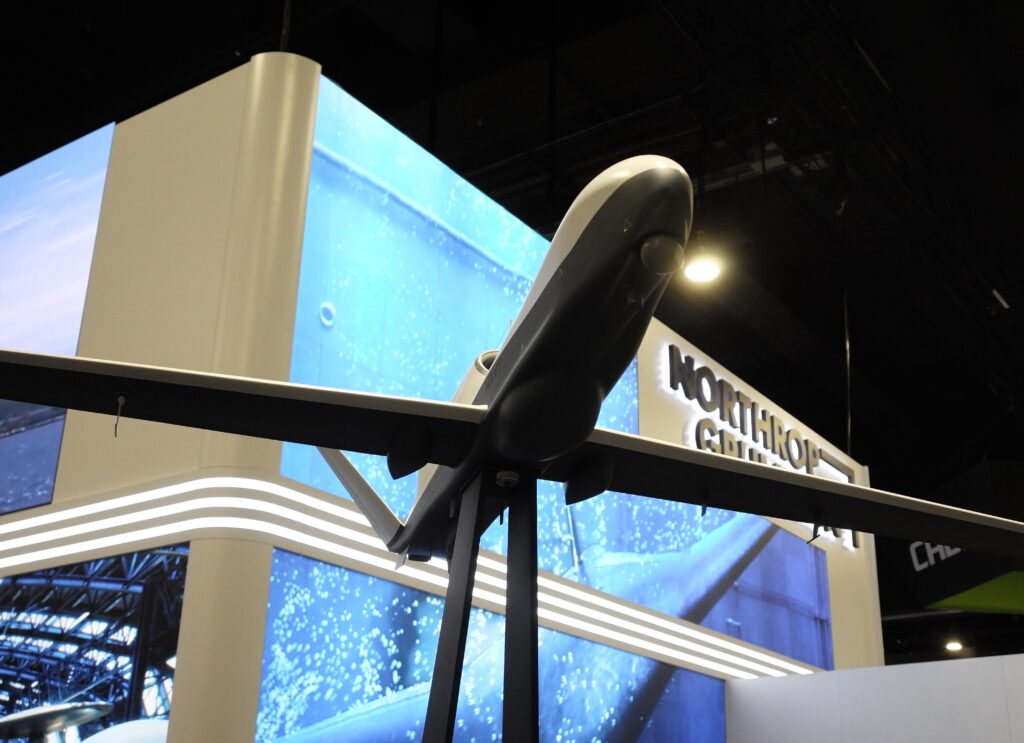
NATIONAL HARBOR, Md. — The Navy’s MQ-4C Triton high-altitude, long-endurance unmanned aerial vehicle is on track for initial operational capability with the new Integrated Functional Capability 4 (IFC-4) with a full orbit of four aircraft in fiscal 2023, a senior official said.
Speaking April 4 to reporters in a roundtable at the Navy League’s Sea-Air Space expo, Rear Adm. Brian Corey, program executive officer for Unmanned and Strike Weapons, said IFC-4, which began flight testing in February, will give the Triton — built by Northrop Grumman (Booth 1300, Dock Space 2) — the capabilities needed to reach IOC and begin to replace the EP-3E Orion maritime reconnaissance aircraft.
The Navy has had the MQ-4C with the baseline IFC-3 capability deployed in 2020 to the Western Pacific in an early operational capability. One aircraft assigned to Unmanned Patrol Squadron (VUP-19) remains deployed while a second has returned to the United States to give maintenance personnel more hands-on experience.
Corey said with IFC-3 “the Navy was not ready to get the network right. We weren’t allowed to connect to the network. We’ve come a long way to an operationally relevant environment.”
The number of planned regional orbits for the Triton originally was planned to be five, with four aircraft each. Beyond the first orbit, the future location and structure of the orbits is less defined and will be determined with regional combatant commander input.
The Navy paused planned procurement of the MQ-4C for two years in 2021 and 2022, but the production line was sustained with an order of three Tritons for Australia and one for the U.S. Navy added in 2021 by Congress, followed by another congressional addition in 2022. The Navy has requested procurement of three Tritons for fiscal 2023.
VUP-19, headquartered at Naval Air Station Jacksonville, Florida, moved its maintenance detachment to nearby Naval Station Mayport, Florida, last year from NAS Point Mugu, California. The future of Point Mugu as a future Triton base is yet to be determined. The second squadron, VUP-11, will be based at NAS Whidbey Island, Washington, but the location of its Tritons there or at Point Mugu or elsewhere will be decided later.
The EP-3E aircraft has a large crew of signals intelligence analysts, and the Triton IFC-4 represents a significant change in the analysis, with onboard processing largely replaced by a wide distribution of the intelligence information across many sites of the intelligence community, Corey said.
Corey said the RQ-4A Global Hawk Broad-Area Maritime Surveillance — Demonstration aircraft which have supported the U.S. 5th Fleet since 2009, remain in service, with Congress having funded the BAMS-D for 2022 despite the Navy’s plan to divest it. The Navy again in the 2023 budget request targets the BAMS-D for retirement, with budget pressures overcoming the utility of the aircraft.
- BlueHalo to Test C-UAS System on Marine Corps JLTV - April 29, 2024
- USS George Washington Deploys to U.S. Southern Command, Eventually Headed to Japan - April 26, 2024
- SECNAV Advocates Increased Legal Immigration to Increase Shipbuilder Workforce - April 23, 2024



